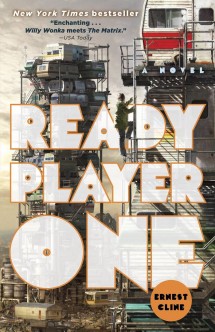Ready Player One – Cline and Spielberg

(“Ready Player One” by Ernest Cline) (2011)
(We bag Spielberg at the bottom).
Ready Player One begins with an aphorism – “‘Being human totally sucks most of the time, Videogames are the only thing that make life bearable.’ Anorak’s Almanac, Chapter 91, Verses 1-2.” If this reminds you of a Bokononism, you are right. Our 2040’s teenage hero Wade Watts names a spacecraft “The Vonnegut”, after one of his favourite 20th century novelists. Readers have complained that this novel is so crammed with 1980’s American pop culture that it is dull as an episode of Family Ties. Well, that’s the point. If you find references to Ladyhawke, Rubik’s Cube, Dungeons and Dragons, Def Leppard, WarGames, Pac-Man, Monty Python, Bill & Ted’s Excellent Adventure and even (ironically) 1984, to be grody to the max, then this simply isn’t the book for you. Read no further. If, however, you are interested in video games, virtual reality worlds and buzzy, amusing soft-sci fi, read on.
18-year-old Wade Watts lives in a grim world. Sometimes he sleeps in the laundry room of his Aunt Alice’s trailer. Fifteen people call the trailer home. That’s one trailer of at least 15 in a stack, one stack in more than 500 stacks of trailers in a park on the outskirts of Oklahoma City. But Wade’s luckier than many in Cline’s world of famine, poverty, killer viruses, war and catastrophic climate change (is any science fiction set in a pleasant place?). Wade wallows in comparative luxury – his secret hideout; a partly flattened cargo van hidden in a mound of dumped cars – made habitable with a power strip, desk lamp, batteries recharged by an exercise bike, a lawn chair and electric heater. His most precious possession is a laptop found in a trash bin, a visor and haptic gloves.
Wade “attends” a virtual school and, like a vast proportion of the global population, spends most of his spare time logged into the virtual world of the OASIS – a “shared synthetic environment” “of “thousands of high-resolution 3-D worlds” in which “players simultaneously coexist inside a simulated world” (virtual reality internet to you and I). Although the orphaned Wade was raised by OASIS interactive educational programs, and acknowledges that he has “the collected knowledge, art and amusements of all human civilization” at his control, like most humans he spends his days playing video games, or participating in interactive soap operas. There’s nothing else to do when there are no jobs, money, space or freedom. Of course, although logging into the OASIS is free, travelling between zones and “in-app purchases” are not (the link between cyber-credits and “real cash” is not adequately explained).
With a nice nod to a different time and a different medium, Wade begins, “Everyone my age remembers where they were and what they were doing when they first heard about the contest. I was sitting in my hideout watching cartoons when the news bulletin broke in on my video feed, announcing that James Halliday had died during the night.” Halliday, one of the two creators of the OASIS, has left a video message called Anorak’s Invitation. (Anorak was the name of Halliday’s online avatar). “The entire video was just over five minutes in length, and in the days and weeks that followed, it would become the most scrutinized piece of film in history, surpassing even the Zapruder film in the amount of painstaking frame-by-frame analysis devoted to it”. This is an example of Cline’s odd use of old technological terms. “Video”? “film” ? And isn’t it unlikely that Wade, an 18-year old child of the cyber-future, would be able to identify a 1960’s historical reference? (Today’s American teenagers seem to be hard put to name the last but one president.) Similarly, Wade is surprised and angry when he learns that the existence of a Christian God is not an unchallenged assumption. Incongruities like this (and others to be mentioned later) do irritate, but this is a richly descriptive and amusing work of pop fiction, so entertainment is the point rather than Dostoyevskyan precision, a little like the OASIS itself.
Although the politics of the 1960’s would be as distant as the Ice Age to Wade’s generation, the movies, music, games and fashion of the 1980’s are not, due to James Halliday’s obsession with the decade in which he was a teenager. And why does Halliday’s obsession suddenly become a global one? Because in his Invitation, Anorak tells the world that he has hidden an Easter egg somewhere in the thousands of worlds of the OASIS and the first to find it will inherit Halliday’s entire fortune – which essentially means owning the OASIS. (We’ll ignore the obvious legal and politico-military problems with this one).
So, The Hunt spawns a global subculture of millions who devote every free moment to searching for the egg. There are three keys to the treasure, one copper, one jade and one crystal, each leading to a cyber-challenge. The clue to the whereabouts of each key lies in a Limerick in the Invitation. A familiarity with Halliday’s obsessions is essential to finding the egg. The millions scour Anorak’s Almanac, a collection of Halliday’s journal entries and observations. Like all the other gunters (“egg-hunters”), Wade downloads every movie, novel, cartoon, game and tv show mentioned in the Almanac. He watches and reads as many as he can. He plays 1980s videogames relentlessly. But after five years, interest in The Hunt dwindles. No avatar’s name has appeared on The Scoreboard on Halliday’s website. No-one has found the first of the keys,
It’s no spoiler (or surprise) to tell you that, to great excitement, the name of Wade’s on-line avatar, Parzifal, appears as the finder of the Copper Key. Unfortunately, the finding of the keys and the solving of the consequent puzzles are the real disappointments of this book. Millions have been trawling Halliday-ania for five years, yet no-one has solved what is, after all, quite a simple riddle cracked by Wade (finally) after a bit of inspired musing. Similarly, the three challenges are surprisingly lack-lustre – anticlimactic, nonsensical and repetitious. It is a shame that the attention which Cline has paid to keeping the technological action captivating and amusing fails at these most important points.
Now that he is the most famous gunter in the world, Wade trades-up, from space in a mangled van to an apartment. The apartment isn’t much to write home about, but the furnishings and fittings are – an armour-plated vacuum sealed War Door, an OASIS immersion rig, a customized OASIS console inside a modded mirror-black Odinware sphere chassis, a Shaptic Technologies HC5000 fully adjustable haptic chair, a Shaptic Bootsuit, state-of-the-art Okagami IdleHands haptic datagloves, Dinatro RLR-7800 WreckSpex, an AboundSound audio system, an Olfatrix smell tower, and best of all, a Okagami Runaround omnidirectional treadmill. It is no coincidence that the Okagami slogan – “No matter where you go, there you are” – reminds us of Buckaroo Banzai and The Brady Bunch. That works, whereas Wade’s system agent software and companion, modelled after the 80’s tv host Max Headroom, is sadly gimmicky and just out of place here.
Parzifal and his friends Aech, Art3mis, Daito and Shoto meet in Aech’s virtual chatroom, the Basement (programmed to look like a rec room circa late 1980s), an exclusive hangout for elite gunters. The comradely antagonistic foulmouthed dialogue between Parzifal and best friend Aech is a somewhat strained attempt at “that’s how the kids talk these days” but is simply annoying. These five hate groups of gunters who operate in clans. More so they hate, loathe and detest the evil global communications conglomerate Innovative Online Industries (“IOI”) which actually enslaves delinquent debtors (there has to be an evil global communications conglomerate). True, we all hate our internet service providers, but as Parzifal says rather dramatically, “my generation has never known a world without the OASIS, an integral part of our lives for as long as we could remember. We’d been born into an ugly world, and the OASIS was our one happy refuge. The thought of the simulation being privatized and homogenized by IOI horrified us in a way that those born before its introduction found difficult to understand. For us, it was like someone threatening to take away the sun, or charge a fee to look up at the sky”. IOI has established an Oology division entirely devoted to searching for the egg. Their egg hunters are known as “Sixer”. “Sixers weren’t hard to spot, because they all looked identical. They were all required to use the same hulking male avatar (regardless of the operator’s true gender), with close-cropped dark hair and facial features left at the system default settings. And they all wore the same navy blue uniform. The only way to tell these corporate drones apart was by checking the six-digit employee number stamped on their right breast, just below the IOI corporate logo.” Sound familiar, Mr. Anderson?
Here’s another shortcoming of the story – IOI establish Parzifal’s identity quickly, much to his rather naïve surprise. Well derrrr. Even today it is frighteningly simple to identify an internet user. Surely the millions would have identified Wade in nano-seconds and torn his liver and lights out for what he knew?
Finally we ask – will the high five triumph? And how can all five triumph in such a super-individual quest? The matter is resolved in a final battle reminiscent of that in “The Lord of the Rings”, another of Halliday’s favourite things. It is, however, much more like that in Ender’s Game (a less interesting book, incidentally).
This novel is great fun. We expect and can bear the lectures about beauty being skin deep. You see (younger readers), it’s possible that you might befriend someone online who is quite different in the real world. Or you could fall in love with a girl who is not as beautiful looking as their avatar…(sigh). “In the OASIS you could become whomever and whatever you wanted to be…In real life, I was nothing but just another sad, lost, lonely soul, wasting his life on a glorified videogame…But not in the OASIS. In there, I was the great Parzifal”.
FOOTNOTE:
Production of Steven Spielberg’s movie of Ready Player One has been put on hold. Just as well, given that Spielberg hasn’t made a film for adults since Duel. Although the novel could be read by Young Adults, it will be diminished by Spielberg’s infantalising touch. The stills do, however, look marvellous and give us the excellent cover of the 2012 Arrow Books print above.
UPDATE:
Here’s Christopher Bray from his review of “Steven Spielberg: A Life in Movies” by Molly Haskell, The Spectator, January 2017.
“What Spielberg can be blamed for, and what Freud-fuelled Haskell inexplicably skates around, is having infantilised movies and their audiences. If you ever glance at the cinema listings and wonder why there’s nothing the even vaguely mature might want to see, blame Spielberg. Terror of adulthood is his primal theme.”
READY, RIDER ONE BY PETER
[Hugo Rifkind recently wrote in The Spectator (7/1/17) of a 2016 Princeton University study “which found that more than a fifth of American men without degrees between the ages of 21 and 30 worked not one day in 2014, often because they were playing computer games instead.”]AND ANOTHER THING: RIDER TWO BY PETER
[Methinks thee be harsh about The Spielberg. Methinks Schindler’s List be a film for adults, or, at least, very sophisticated children…]Leave a comment...
While your email address is required to post a comment, it will NOT be published.



0 Comments